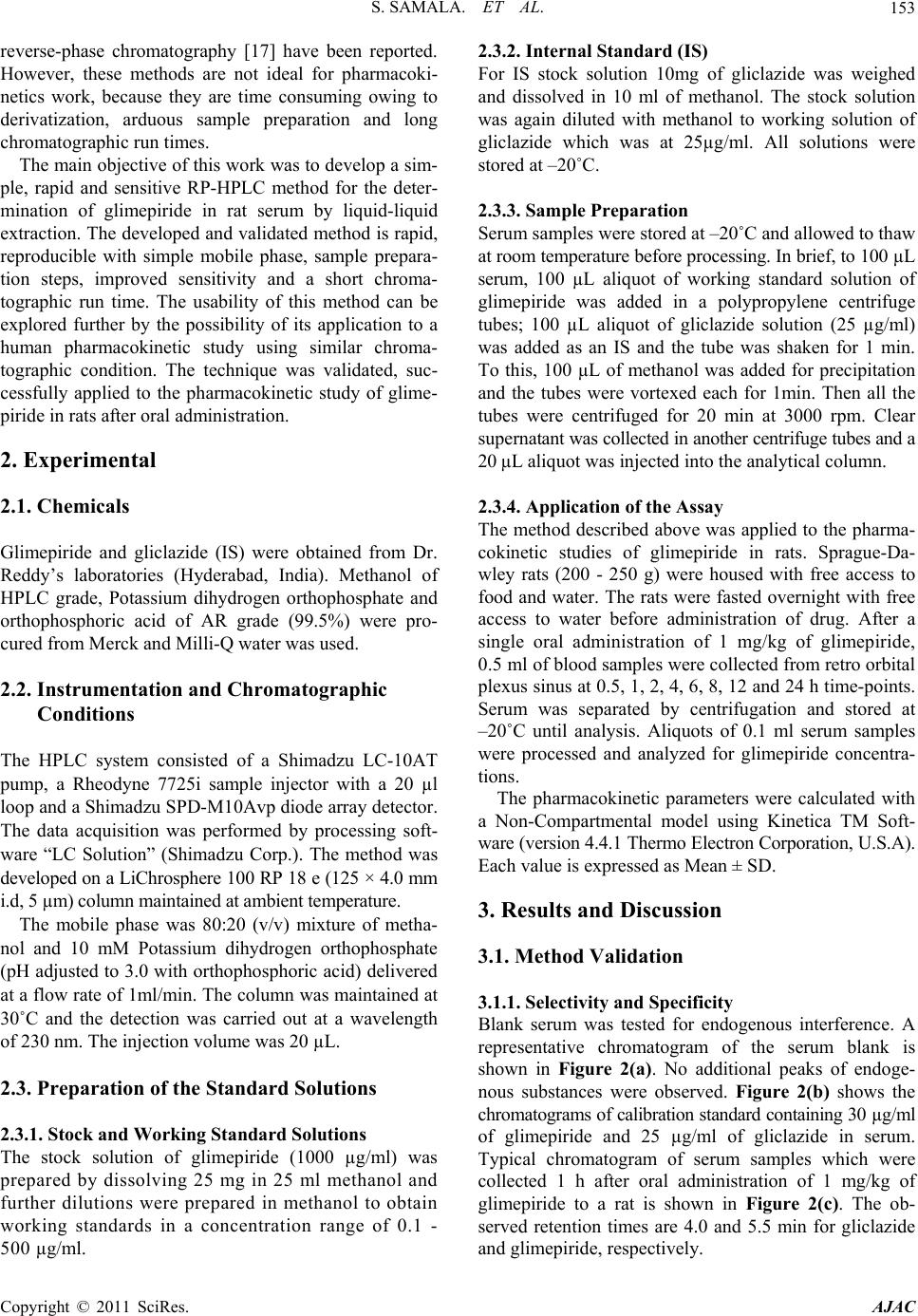
S. SAMALA. ET AL.153
reverse-phase chromatography [17] have been reported.
However, these methods are not ideal for pharmacoki-
netics work, because they are time consuming owing to
derivatization, arduous sample preparation and long
chromatographic run times.
The main objective of this work was to develop a sim-
ple, rapid and sensitive RP-HPLC method for the deter-
mination of glimepiride in rat serum by liquid-liquid
extraction. The developed and validated method is rapid,
reproducible with simple mobile phase, sample prepara-
tion steps, improved sensitivity and a short chroma-
tographic run time. The usability of this method can be
explored further by the possibility of its application to a
human pharmacokinetic study using similar chroma-
tographic condition. The technique was validated, suc-
cessfully applied to the pharmacokinetic study of glime-
piride in rats after oral administration.
2. Experimental
2.1. Chemicals
Glimepiride and gliclazide (IS) were obtained from Dr.
Reddy’s laboratories (Hyderabad, India). Methanol of
HPLC grade, Potassium dihydrogen orthophosphate and
orthophosphoric acid of AR grade (99.5%) were pro-
cured from Merck and Milli-Q water was used.
2.2. Instrumentation and Chromatographic
Conditions
The HPLC system consisted of a Shimadzu LC-10AT
pump, a Rheodyne 7725i sample injector with a 20 µl
loop and a Shimadzu SPD-M10Avp diode array detector.
The data acquisition was performed by processing soft-
ware “LC Solution” (Shimadzu Corp.). The method was
developed on a LiChrosphere 100 RP 18 e (125 × 4.0 mm
i.d, 5 µm) column maintained at ambient temperature.
The mobile phase was 80:20 (v/v) mixture of metha-
nol and 10 mM Potassium dihydrogen orthophosphate
(pH adjusted to 3.0 with orthophosphoric acid) delivered
at a flow rate of 1ml/min. The column was maintained at
30˚C and the detection was carried out at a wavelength
of 230 nm. The injection volume was 20 µL.
2.3. Preparation of the Standard Solutions
2.3.1. Stock and Working Standard Solutions
The stock solution of glimepiride (1000 µg/ml) was
prepared by dissolving 25 mg in 25 ml methanol and
further dilutions were prepared in methanol to obtain
working standards in a concentration range of 0.1 -
500 µg/ml.
2.3.2. Internal Standard (IS)
For IS stock solution 10mg of gliclazide was weighed
and dissolved in 10 ml of methanol. The stock solution
was again diluted with methanol to working solution of
gliclazide which was at 25µg/ml. All solutions were
stored at –20˚C.
2.3.3. Sample Preparation
Serum samples were stored at –20˚C and allowed to thaw
at room temperature before processing. In brief, to 100 µL
serum, 100 µL aliquot of working standard solution of
glimepiride was added in a polypropylene centrifuge
tubes; 100 µL aliquot of gliclazide solution (25 µg/ml)
was added as an IS and the tube was shaken for 1 min.
To this, 100 µL of methanol was added for precipitation
and the tubes were vortexed each for 1min. Then all the
tubes were centrifuged for 20 min at 3000 rpm. Clear
supernatant was collected in another centrifuge tubes and a
20 µL aliquot was injected into the analytical column.
2.3.4. Appl ic a ti on of the Assay
The method described above was applied to the pharma-
cokinetic studies of glimepiride in rats. Sprague-Da-
wley rats (200 - 250 g) were housed with free access to
food and water. The rats were fasted overnight with free
access to water before administration of drug. After a
single oral administration of 1 mg/kg of glimepiride,
0.5 ml of blood samples were collected from retro orbital
plexus sinus at 0.5, 1, 2, 4, 6, 8, 12 and 24 h time-points.
Serum was separated by centrifugation and stored at
–20˚C until analysis. Aliquots of 0.1 ml serum samples
were processed and analyzed for glimepiride concentra-
tions.
The pharmacokinetic parameters were calculated with
a Non-Compartmental model using Kinetica TM Soft-
ware (version 4.4.1 Thermo Electron Corporation, U.S.A).
Each value is expressed as Mean ± SD.
3. Results and Discussion
3.1. Method Validation
3.1.1. Selectivity and Specificity
Blank serum was tested for endogenous interference. A
representative chromatogram of the serum blank is
shown in Figure 2(a). No additional peaks of endoge-
nous substances were observed. Figure 2(b) shows the
chromatograms of calibration standard containing 30 µg/ml
of glimepiride and 25 µg/ml of gliclazide in serum.
Typical chromatogram of serum samples which were
collected 1 h after oral administration of 1 mg/kg of
glimepiride to a rat is shown in Figure 2(c). The ob-
served retention times are 4.0 and 5.5 min for gliclazide
and glimepiride, respectively.
Copyright © 2011 SciRes. AJAC